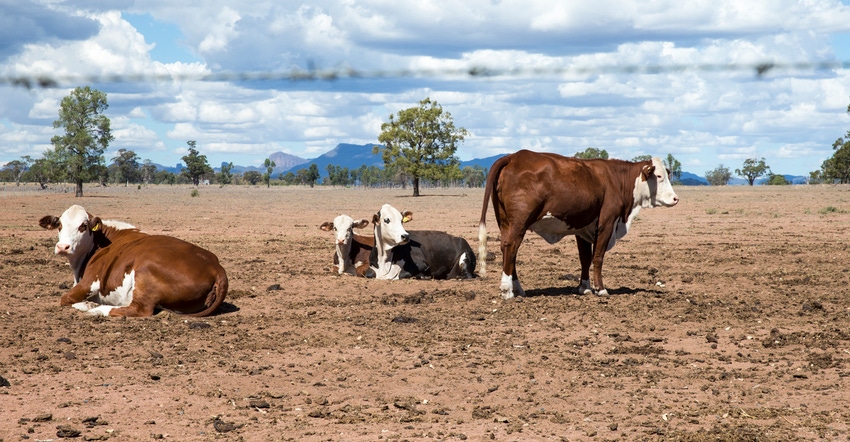
Editor’s note: This is the second in a two-part beef market update with ag economist Derrell Peel. For Part 1, see Beef market a mixed bag this year.
Two big issues will paint the upcoming beef market picture — drought and feed markets. Derrell Peel, professor in the Oklahoma State University Department of Agricultural Economics, says those two factors will impact the beef world more than they have in recent years.
One glance at the U.S. Drought Monitor map shows both North Dakota and South Dakota classified as at least “abnormally dry,” with large portions in the “moderate and severe drought” zones, and even some in “extreme drought” in the southeast corner of South Dakota. “If this map looks like this or anything close to this two to three months from now,” Peel says, “then it’s a big deal for the whole industry, and certainly for the producers affected.”
Peel points out that a drought that starts in the first half of the year is particularly devastating. “It becomes a problem much faster than drought that develops later in the year, after you’ve already grown some crops and grown some forage.”
On a national level, Peel says Dec. 1 hay stocks were down, although they had been strong through 2020. As for corn, prices will increase. But “that doesn’t mean we’re not going to feed them,” he says. “We’re still going to feed cattle, because the feeder cattle that we need to feed this year are already out there. We can’t just shut off production immediately in this industry.”
Peel sees feedlot operators making decisions about placement weights on cattle, “when they look at a choice between buying pounds versus putting on pounds. When the cost of gain gets high, they’re going to be more interested in buying more of those pounds, placing those cattle bigger, cutting down on days on feed and so on.”
Strong carcass weights
To start off 2021, Peel says the carcass weights are strong, mirroring what was seen at the start of last year. “Part of that was the pandemic that we backlogged cattle and kept them high at the time of year when they should have been dropping seasonally. At the moment, it’s not heading toward a seasonal low, although I think it probably will shortly. I think we will start to see these carcass weights come down and those high feed prices as we work through the year will have some impact on carcass weights, as well.”
Though steer carcass weights have been trending upward since 1960, on average 4 pounds a year, Peel says the pandemic-induced backlog led to a one-year jump of 28 pounds in steer carcass weights. “In the last two to three decades, they’ve gone up closer to 5 or 6 pounds a year,” he says. “I don’t expect that to persist,” referring to the large carcass weight growth seen last year. He adds that 2020 was the first year that steer carcass weights averaged over 900 pounds for an entire year.
Bottomline for 2021
Looking at beef cattle prices, Peel tells producers to see increases of 5% to 9% year over year on an annual basis, regarding both calves and feeder cattle. “I think much of that improvement happens in the second half of the year. And actually, by the time we get to the fourth quarter if you’re a cow-calf guy selling calves in the fall, it may actually look better than that, or certainly has the potential to look better than that. The 5% to 9% is sort of averaging across a kind of a rough first half of the year, and probably better in the second half of the year.”
Peel warns of factors that could alter that prognosis. “There’s a number of things to keep an eye on that could be a bit of a drawdown. But overall, it looks to me like the second half of the year has the potential to actually show quite a bit of improvement on a year-over-year basis.”
Expansion or liquidation?
Peel says the beef cattle industry is at a precipice, of seeing either an expansion or contraction.
“I think the industry in general is kind of waiting for some direction from the broader set of market conditions both in the U.S. and globally to figure out where we’re going to go from here,” he says. “I think after this year, we could actually be back in some level of expansion — probably not really dramatic, but it’s possible. Obviously, if more negative things should come to bear on this industry we can clearly go into a more active liquidation. At this point, I don’t really see that happening, but that’s kind of the situation. We’re sort of poised to move either direction depending on what happens.”
About the Author(s)
You May Also Like






